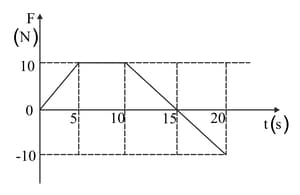MEDIUM
Earn 100
Discuss briefly Galileo's ideas about motion.
Important Questions on Force and Laws Of Motion
EASY
EASY
EASY

Which one of the following statements is correct for the interval from ?
EASY
Find the retardation with which a train moving at is brought to rest in seconds.
EASY
MEDIUM
Describe Galileo's experiment. What was the result of this experiment ?
EASY
EASY
EASY
A moving body comes to stop without an application of force. Comment.
MEDIUM
A body moves with constant velocity of . The mass of body is . The unbalanced force acting on the body is _____ .
MEDIUM
Give scientific reasons.
Even though the magnitude of action force and reaction force are equal and their directions are opposite, their effects do not get cancelled.
EASY
EASY
Define Newton's first law and Inertia.
MEDIUM
EASY
EASY
EASY

